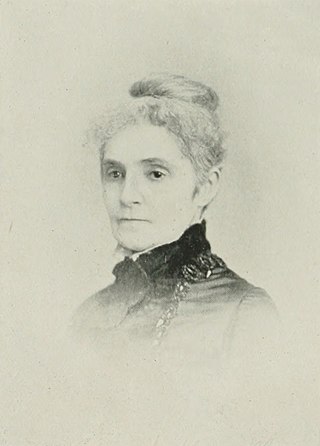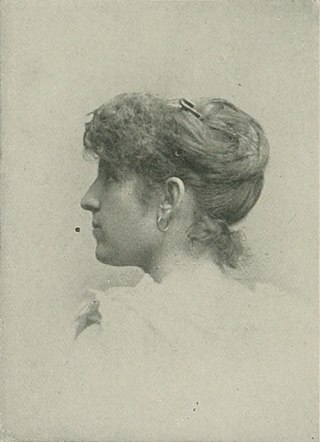
Edward Eggleston was an American historian and novelist.

Elizabeth Eggleston Seelye was an American writer and biographer. Her story "The A.O.I.B.R.", which appeared in Harper's Bazaar in 1889 with an illustration of a child reading, is cited by the Rockwell Centre for American Visual Studies as an early illustration of a girl reading. Allegra Eggleston and Rosina Emmet Sherwood provided illustrations for Seelye's stories.
Elwyn Seelye was the founder of the New York State Historical Association and the first custodian of the Lake George battlefield site.

Blanche Annie Dillaye was a 19th-century artist from the U.S. state of New York. After studying at the Pennsylvania Academy of Fine Arts, she became one of the significant figures in the American etching revival movement. She acquired prominence in one of the most difficult of arts, and was accepted in some respects as an authority in a field where far more men than women were in competition.

Mary Hannah Gray Clarke was an American author, correspondent, and poet from Rhode Island. She wrote extensively for magazines and for the public press, and was also the author of many dramas, lyric poems, operettas, stories for the young, and essays. In addition to the operettas, "Just Like Cinderella" and "Jack Frost's Visit to the Fairies", her works included "Effle, Fairy Queen of Dolls," "Prince Pussin-Boots," "Golden Hair and her Knight of the Beanstalk in the Enchanted Forest," "Obed Owler and the Prize Writers," "How I Came to Leave Town and What Came of It," "Edith Morton, the Sensible Young Lady;" "The Story that the Willow Basket Told to Faith Fairchild;" "English Lyrics;" and "Home;" as well as a number of songs, such as "Were it not for Dreams;" ; "Twittering Swallow;" "Robin, Robin, Bold and Free;" "Down by the River;" "Not to Blame;" and "Our-Leafed Clover."

Sarah Elizabeth Bierce (1838–1898) was an American journalist and educator who was a charter member of the Woman's Press Club of Cleveland.

Harriet Newell Kneeland Goff was an American temperance reformer and author. For many years, she was a contributor to the public press, and three books followed, Was it an Inheritance? (1876), Other Fools and Their Doings, Or, Life Among the Freedmen (1880), and Who Cares (1887). She was elected Right Worthy Grand Vice-Templar of the British branch in the rupture of the International Organisation of Good Templars. She was an international temperance lecturer beginning in 1870, and for six years, her especial work was for the employment of police matrons in Brooklyn, New York. Goff was the first woman ever placed upon a nominating committee to name candidates for the presidency and vice-presidency of the United States.

Mary Elizabeth Sherwood was an American author and socialite. She wrote short stories, poetry, several books, and etiquette manuals, in addition to contributing to many magazines and translating poems from European languages. Among her writings are The Sarcasm of Destiny, A Transplanted Rose, Manners and Social Usages, Sweet Briar, and Roxobel. Better known as Mrs. John Sherwood, some of her literary works were published as "M.E.W.S." or "M.E.W. Sherwood".

Helen M. Winslow was an American editor, author, publisher, and journalist. She began her work on Boston papers. Winslow served as dramatic editor on The Beacon, 1891–97; editor, Woman's Club Department, Boston Transcript, 1893–98; editor, Woman's Club Department of the Delineator, 1897, and again 1912; editor and publisher, The Club Woman, 1897-1904; and she was the publisher of the Official Register of Women's Clubs in America from 1897. She was the author of Salome Sheppard, Reformer. 1893; Concerning Cats, 1900; Concerning Polly, 1902; Literary Boston or To-day, 1902; The Woman of To-morrow, 1905; The President of Quex, 1906; Peggy at Spinster Farm, 1908; A Woman for Mayor, 1910; The Pleasuring of Susan Smith, 1912; and At the Sign of the Town Pump, 1913. She collaborated with Frances Willard in Occupations for Women, and with Marie Wright in Picturesque Mexico.

Julia Ditto Young was an American poet and novelist.

Elia Goode Byington was an American journalist. With her husband, she was joint proprietor, editor, and manager of the Columbus Evening Ledger. Byington served as President of the Georgia Women's Press club. She died in 1936.

Emma Elizabeth Brown, pen names B. E. E. and E. E. Brown, was an American author of prose, biographies, and poetry. She was also an artist.

Helen A. Manville was an American poet and litterateur of the long nineteenth century. Under the pen name of "Nellie A. Mann", she contributed largely for leading periodicals east and west, and obtained a national reputation as a writer of acceptable verse. At the height of her fame, she decided to stop using the pen name and assume her own. She succeeded in making both names familiar, virtually winning laurels for two cognomens, when ill-health required a pause in her literary work. A collection of her poems was published in 1875, under the title of Heart Echoes, which contained a small proportion of her many verses.

Martha Capps Oliver was an American poet and hymnwriter. She was the author of A Year of Sacred Song (1895), A Year's Good Wishes (1895), Round the Year with the Poets (1900), The Far West, Easter Legend, and Christmas Legend, as well as several hundred Easter and Christmas booklets and poems, numerous songs, hymns, anthems, and cantatas. Oliver died in 1917.

Louise Markscheffel was an American literary and society editor of the long nineteenth century, as well as dramatic, musical and literary critic. Beginning in 1887, she served as society editor of the Toledo Journal. In 1897, she published Hints on coffee making : for the use of housekeepers who aim for the best.

Lydia Hoyt Farmer was a 19th-century American author and women's rights activist. For many years, Farmer contributed to the leading newspapers and magazines, on various lines: poems, essays, juvenile stories, historical sketches and novels. She was of a deeply religious nature, and endeavored to tinge all her writings with a moral as well as an amusing sentiment. She edited What America Owes to Women, for the Woman's Department of the World's Columbian Exposition. Her works included: Aunt Belindy's Point of View; The Doom of the Holy City; A Story Book of Science; A Knight of Faith; Short History of the French Revolution; Girls' Book of Famous Queens; What America Owes to Women; and others. Farmer died in 1903.

Susan H. Wixon was an American freethought writer, editor, feminist, and educator of the long nineteenth century. She was a member of the Fall River School Board for 24 years. Wixon especially espoused the cause of women and children. In both politics and religion, she held radical views. She was the author of Apples of gold, and other stories for boys and girls (1876), Summer days at Onset (1887), Woman : four centuries of progress (1893), Sunday observance, or, How to spend Sunday (1893), Right living (1894), All in a lifetime : a romance (1894), and Some familiar places (1901).

Nellie Marie Burns was a 19th-century American actor and poet.

Jessie Fremont O'Donnell was a 19th-century American writer of poems, novels and magazine articles, as well as a lecturer. In December, 1887, her first book, Heart Lyrics appeared. Later books were Love Poems of Three Centuries, Three Centuries of English Love-Songs, A Soul from Pudge's Corners, and others, besides contributions to various U.S. periodicals. She also wrote essays, short stories, and character studies.

Margret Holmes Bates was an American author better known by her pen names, Mrs M E Holmes, Margret Holmes, Margret Holmes Bates, and Margaret Holmes Bates. Her first publication was entitled, Manitou, the plot of which centered around Rochester, Indiana and Indianapolis, Indiana. One of her most noted books, Hildegarde, was a poetry collection, dedicated to her son, Charles.






















